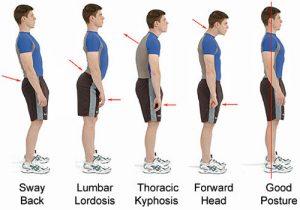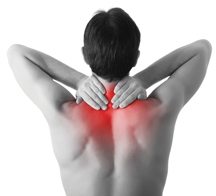If you have ever experienced pain in your middle back (what chiropractors will call the thoracic area), you have plenty of company. While lower back pain is probably the most common compliant among the general population, middle back pain isn’t far behind! One study estimates that as much as 30 percent of working adults experience at least one episode of middle back pain each year.[1]
The good news is that the fundamental cause of mid back pain is often the same – in one sense or another, the spine is being over stressed. The most common reason for this is a condition known as vertebral subluxation, with other issues such as referred pain also being a frequent culprit. Today, lets take a look at some of the common causes of mid back pain.
Poor posture

Examples of common postural problems
With today’s lifestyle requiring ever greater time spent at a desk, some degree of poor posture is almost unavoidable. At complete chiropractic we provide our clients with simple and quick postural improvement exercises which can go a long way to combating the problem – but a regular chiropractic check up is the best way to go in preventing long terms issues from poor posture.
Poor (hunched) postures are a problem because they work against the body’s natural stabilization mechanisms, normally controlled by a balance of muscles and gravity, thus subjecting the spine to excess strain – ordinarily the force of gravity should be directed down the spine in a way which its ideally constructed to cope with – being hunched over results in the spine being “pulled” out of alignment instead.[2]
To help avoid problems at your desk, ensure your chair ha sufficient back support – if required grab a additional support which you can fit to the chair. Today these kinds of devices are cheap and easy to obtain, but can make a big difference. In addition, try not to sit too far away from your keyboard, in order to avoid “reaching”.
Attention to posture is essential for athletes too – runners (and those participating in running based sports) in particular may benefit from postural analysis, of the kind we offer to all our clients. Detecting minor problems early, before you might even notice them makes it easy and simple to correct and issue which might otherwise end up leading to an injury Golfers and tennis players may also benefit from a swing analysis by a professional instructor.
Physical Stress
Repetitive work (such as typing, lifting or running items through a check out counter), as well as repetitive sports activities (such as swinging a bat, kicking a soccer ball or lifting weights), are major causes of vertebral subluxation and related pan in the middle back.
At an initial consultation, we go through these kinds of issues with you to try to identify any activities which might be causing your problem – sometimes its possible to make changes which will reduce the strain of everyday activities, but thankfully chiropractic adjustments are a sure-fire way to counter subluxation, if changes in your work routine aren’t practical.
Emotional Stress
Emotional stress is a significant instigator of vertebral subluxations – we often talk about feeling tense or tight when we’re stressed or upset, and with good reason! A growing body of research demonstrates that emotional stress, anxiety and depression dramatically boost the odds of developing back problems, including middle back pain.
A study performed by researchers from the Centers for Disease Control and Prevention, the National Institute for Occupational Safety and Health and the University of Pittsburgh included more than 6,000 shop assistants in 160 newly opened retail stores. After adjusting for each patient ‘s history of back problems and work related lifting, researchers found that the risk of back pain was moderately increased among employees with intensely demanding jobs, high levels of job dissatisfaction and stressful time demands[3].
Where possible, we like to work with clients to reduce their stress, but this isn’t always viable. Thankfully, chiropractic adjustments can correct the subluxations – but for many clients the process is also a relaxing one in and of itself. Many people report a sense of wellbeing and calm after an adjustment, so while chiropractic adjustment is not a treatment for stress or depression in and of itself, it can certainly form part of a broader stress reduction plan! At complete chiropractic we also offer massage which can be an excellent complement to your chiropractic treatment.
Misaligned Ribs
Just as spinal bones may become misaligned or subluxated , so may ribs.
Subluxations of the ribs often result in “trigger points” of pain , causing the smooth muscles around the ribs to spasm. Patients who complain of “knots” in their upper backs are often really suffering from misaligned ribs. In some cases, the sharp, jabbing nature of the pain can mimic heartburn. Chiropractic treatment isn’t just for the spine, and studies show that chiropractic adjustment may provide an effective mode of treatment here too.[4]
In many cases we can also recommend specific exercises, which provide additional stability to the area.
Referred Pain
The spine, despite being comprised of individual vertebrae should be thought of as a single organism, which works together. This means that pain in the middle back is sometimes the result of a vertebral subluxation in another part of the spine, such as the neck (cervical spine) or the low back (lumbar spine).
For instance, in one case study, a patient experienced thoracic as well as lumbar pain due to an exaggerated curve in the neck. When the patient ‘s neck position was corrected, pain throughout the entire back diminished.[5]
This kind of situation is actually very common, and its why we always focus on the entire spine and any other aches and pains you might be suffering from at your initial consultation.
Osteoarthritis
Middle back pain may indicate the presence of osteoarthritis, especially in older individuals. This condition is also typically related to vertebral subluxations of the thoracic spine.
A chronic degenerative disorder, osteoarthritis is characterized by cartilage loss which results in pain and stiffness. In severe cases OA of the thoracic spine results in “hunchback”. Regular chiropractic care may ward off the condition before it develops. You can read more about preventing osteoarthritis here.
Mattress and Sleeping Position
You probably shouldn’t ignore all those mattress adverts from TV, because very often thoracic pain that occurs at night or on waking may be due to inadequate mattress support. A poor sleeping position may also be to blame.
Research shows that proper back support while lying down distributes the force of gravity evenly across the back, keeping the spine in a neutral position and reducing pain[6]. There’s also some suggestion that people who sleep on the same side each night, or on their stomachs, may be at an elevated risk of back pain – but in a practical sense proper support is probably far more important.
Sleeping position recommendations are the kind of thing that we can help with – once we’ve ruled out any of the more common causes… sometimes however it might just be time for a new mattress!
Beating back pain is what we do
As a chiropractor, beating back pain is my number one focus. We see more patients every day for back pain than any other issue – it’s a problem that many people suffer with for years, but thankfully its one that we can correct quickly, painlessly and (with regular maintenance) forever.
With Christmas coming up, why not give a chiropractic initial consolation (we have a special offer here!) as a truly meaningful present for someone you care about?
[1] J Occup Health 2009;51:177-92
[2] Electromyogr Clin Neurophys iol 2008;48:359-65
[3] Am J Ind Med 2003;43: 179-87
[4] J Ma nipulative Physiol Ther 2003 ;26: 108
[5] J Chiropr Med 2002 ; 1 :1 13-5
[6] J Can Chiropr Assoc 2005;49:96-10 I



